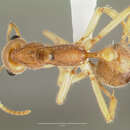Biology
provided by Arkive
These and some other Australian ants (the 'bulldog ants (Myrmeciinae)) belong to an ancient linage and have simpler social systems than other modern ants (5). Mature Nothomyrmecia colonies are generally small at 50 - 120 adults (2). The newly mated queens initiate colony foundation in groups of 2 or 3; the dominant female subsequently evicts the subordinate individuals from the nest once the first workers appear (4). The workers of the colony tend the brood and actively hunt for food on trees near the nests. They use their stings to stun prey, such as other invertebrates, which are returned without dissection (5). Unlike most species of ants, Nothomyrmecia workers are able to tolerate low temperatures and tend to forage after dusk when temperatures have dropped to 5 - 10 °C (2). It is thought that the low temperatures may assist foraging, making prey slower and therefore less likely to escape (2). Workers navigate between the nests and forage trees by using the silhouette of the tree canopy like a map (4).
The most significant and unique primitive features of Nothomyrmecia are behavioural (5). Unlike all other studied ants, there is virtually no evidence of worker division of labour within the nests, although some individuals spend extended periods near the queen, and some may act as guards within the nest entrances for up to several days (5). Field experiments involving the marking of foragers and later excavation of subject colonies, show that all but one or two workers may leave the nest to forage over a period of only 2 or 3 nights; the exceptions are believed to be the entrance guards (5). Thus the most elementary and minimal level of task specialisation seen in other ants (that between foragers and in-nest specialists) is absent. Otherwise the workers forage alone and show no evidence of cooperative behaviour, apart from living together in the nest (5). Nothomyrmecia has been referred to as the 'least sociable' of all ants (5).
Conservation
provided by Arkive
No conservation measures are currently in place.
Description
provided by Arkive
This ant of ancient lineage is described as a 'living fossil.' It is perhaps the most 'primitive' ant still alive today (2). Ants are social insects, which typically live in colonies within nests comprising a single reproductive 'queen' and a force of non-reproductive 'workers', of whom the queen is the mother. Unlike the workers, virgin queens possess wings that are used only once for flight in a mating swarm, following which the wings are shed and the now fertilised queens begin colony foundation, typically alone (5). Seasonally, nests include immatures: eggs, larvae and pupae. Males, which are winged and develop from unfertilised eggs, are present only periodically each year, prior to the breeding season (5). The individual workers typically perform different roles; a characteristic known as 'polyethism' or 'division of labour' (5). Minimally, there are individuals specialised as foragers, working outside the nests, and others, which seldom leave the nests but perform in-nest activities, such as brood care. In advanced species these worker 'castes' may be physically differentiated, often including large-headed 'soldiers' (5). Nothomyrmecia workers are pale yellow in colour and have large eyes, distinctively long mandibles and a powerful sting (3); there is no soldier caste (5). Unusually, the queens have extremely reduced wings that are unlikely to be functional for flight (2). Virgin queens probably mate with flying males on tree trunks or the ground; the function of the reduced wings is not known (5).
Habitat
provided by Arkive
Colonies inhabit nests excavated in the soil (3), beneath eucalyptus trees (4).
Range
provided by Arkive
Originally known from extreme southern Western Australia, this species was thought to be extinct until it was rediscovered near Poochera in South Australia in 1977 (4). Its known range has been recently extended to other areas of southwestern South Australia (5).
Status
provided by Arkive
Classified as Critically Endangered (CR - B1+2c) on the IUCN Red List 2002 (1).
Threats
provided by Arkive
This species has a restricted distribution, and is known only from a small number of sites. Nothomyrmecia is closely associated with eucalyptus trees and is therefore extremely vulnerable to their removal or damage by fire. An underground telephone line was installed at the famous rediscovery site near Poochera, and this led to the almost complete destruction of the then only known population (4).

